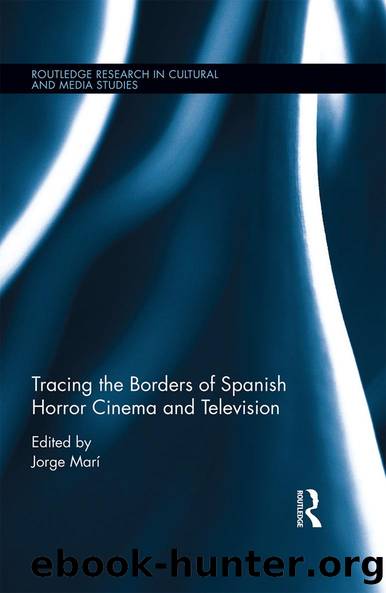Tracing the Borders of Spanish Horror Cinema and Television by Jorge Marí

Author:Jorge Marí [Marí, Jorge]
Language: eng
Format: epub
ISBN: 9780367886882
Barnesnoble:
Publisher: Taylor & Francis
Published: 2019-12-10T00:00:00+00:00
Conclusion: From the Mechanical and the Mental to Magical Sound
Sound functions in order to frighten characters and spectators alike. It builds-up the suspense in films that can be classified under very different genres: thriller, horror, gore, intimate drama, war and horrific fairy tale. Bass vibration refers to evil. The Devil in El DÃaâ¦, the toad in Nadie⦠and El Laberintoâ¦, the killer in Tesis and the captain in El Laberintoâ¦, have harrowing breaths. Even the loversâ puffs in Secretos⦠can provoke anxiety. In many cases âmachinesâ interpose between the heroes and the evil. Acousmatics sounds, and acousmêtres, fool the spectators and the heroes into hoping to discover the real danger. Radio, TVs, VCRs and computers give oppressive sounds. Synthetic voices and digital sound effects tormented the spectator in the 1990s. The music played in a radio drama from the 1950s. In Secrets of the heart, is mixed with âghost voicesâ. In the Labyrinth of Pan, the last trace of a mechanical sound machine is the captainâs gramophone, but it is no longer a horrifying sound. It suggests that the fascist is not human; he is just a mechanical killer, without any feelings. Because of the gift of his dying fatherâa clock he constantly has to repairâthe man is suspended in the gearwheels of a monstrous death machine. Because of the injunction given by his father, he has no choice but to kill and be killed.
In the 1990s acousmêtres invaded Spanish films. By the end of the films they were âde-acoumatisedâ, and the monsters took on a human appearance and could then be killed. These feelings of distress could also be linked to the misunderstanding of simple sounds. In 2006âs Guillermo del Toroâs imaginarium, monsters are part of an animist vision of the world. Only the child can hear and see them, and even though they can be dangerous the real world is far worse.
The films we analysed illustrate how religious beliefs are replaced by superstition, perhaps caused by the media. Media, from the radio to the computer, create horrendous sounds. They manipulate people. Digital sound effects, made with complex sound-mixing techniques, become the frightening elements since they come out of machines. Here, the filmmakers and their sounds designers provide us with an interesting mise en abyme. When those sounds are simply natural elements, like a human sigh of pleasure, they help to understand life (e.g. in Secretosâ¦). New technologies in Spanish films seemed to be dangerous in 1990s, this was mainly due to the subjective interpretation of the sound made by a character. Internal subjective sound explains the harrowing sounds. The real sound space is the brain of the characters, the place where fear resonates is our head.
From the 1990s to the 2000s, the suggestion of fear and danger that was contained primarily in sound then found its way into images. Mental sounds heard only by one person, or by two frightened kids, became a powerful music surrounding the characters, and the killing of an innocent person is shown directly.
Download
This site does not store any files on its server. We only index and link to content provided by other sites. Please contact the content providers to delete copyright contents if any and email us, we'll remove relevant links or contents immediately.
| Direction & Production | Genres |
| Guides & Reviews | History & Criticism |
| Reference | Screenwriting |
| Shows |
Robin by Dave Itzkoff(2387)
Head of Drama by Sydney Newman(2257)
I'm Judging You by Luvvie Ajayi(2151)
The Paranormal 13 (13 free books featuring witches, vampires, werewolves, mermaids, psychics, Loki, time travel and more!) by unknow(2052)
Ten by Gretchen McNeil(1832)
Single State of Mind by Andi Dorfman(1762)
#MurderTrending by Gretchen McNeil(1615)
Key to the Sacred Pattern: The Untold Story of Rennes-le-Chateau by Henry Lincoln(1595)
Merv by Merv Griffin(1567)
Most Talkative by Andy Cohen(1548)
This Is Just My Face by Gabourey Sidibe(1438)
Notes from the Upside Down by Guy Adams(1415)
The Hunger Games: Official Illustrated Movie Companion by Egan Kate(1389)
Springfield Confidential by Mike Reiss(1365)
Jamie Oliver by Stafford Hildred(1357)
Binging with Babish by Andrew Rea(1330)
Clarkson--Look Who's Back by Gwen Russell(1309)
The TV Writer's Workbook: A Creative Approach To Television Scripts by Ellen Sandler(1300)
Blue Planet II by James Honeyborne & Mark Brownlow(1238)
